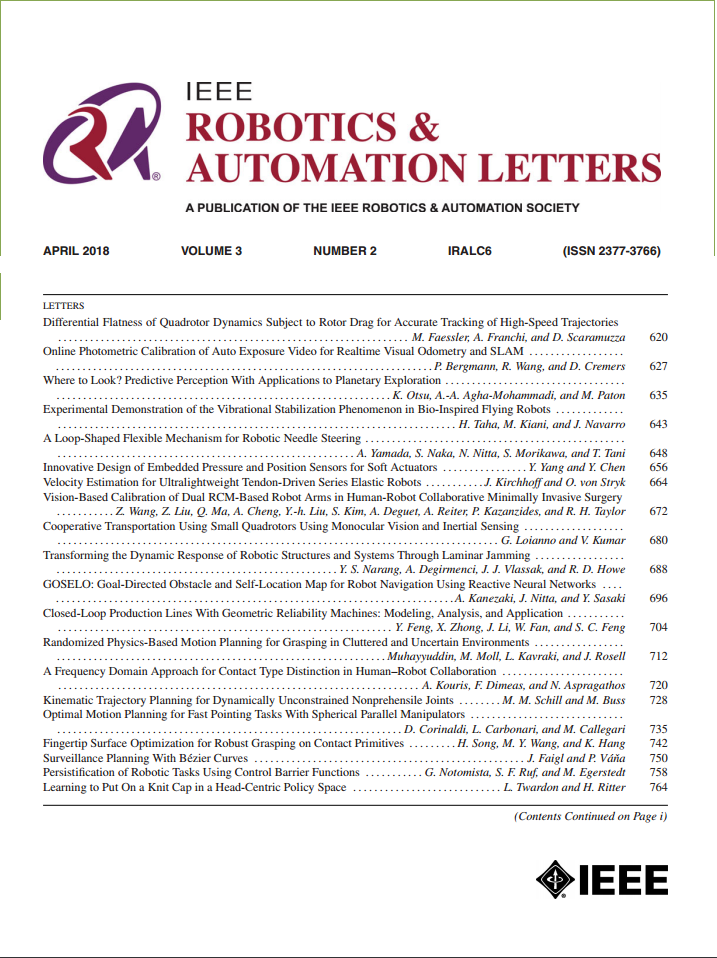Optimized Design and Calibration of a Human-Eye-Sized Active Binocular Vision System Based on Spherical Parallel Mechanism
IF 4.6
2区 计算机科学
Q2 ROBOTICS
引用次数: 0
Abstract
The Active Binocular Vision System (ABVS), resembling the human eye, demonstrates potential for improving visual perception in robotic systems, especially in dynamic and complex environments. In this letter, we present an optimized design of a three degree-of-freedom (DoF) Active Monocular Vision System (AMVS) based on a Spherical Parallel Manipulator (SPM). By combining two identical AMVS units, we form an ABVS, which has been successfully integrated into a humanoid robotic head. Due to the highly nonlinear kinematics of SPM and complex error coupling in its multi-link structure, traditional end-to-end neural network training methods are insufficient in accuracy and require large datasets. To address these challenges, we propose a two-branch optimization network that significantly improves calibration accuracy. Furthermore, we introduce a four-branch fine-tuning strategy that enables accurate kinematic models to be obtained with only a small amount of data from new AMVS devices. Experimental results demonstrate that the two-branch optimization network reduces rotational prediction error by 16% and translational error by 5% compared to a single-branch network. Furthermore, the four-branch fine-tuning network achieves comparable accuracy to a fully trained single-branch network using only 343 data points. Finally, our ABVS shows the capability to perform 3D visual tasks, such as stereo reconstruction during movement.基于球面并联机构的人眼大小主动双目视觉系统优化设计与标定
主动双目视觉系统(ABVS),类似于人眼,展示了在机器人系统中改善视觉感知的潜力,特别是在动态和复杂环境中。本文提出了一种基于球面并联机械臂(SPM)的三自由度主动单目视觉系统的优化设计。通过将两个相同的AMVS单元组合在一起,我们形成了一个ABVS,并成功地集成到一个人形机器人的头部中。由于SPM运动高度非线性,多链路结构误差耦合复杂,传统的端到端神经网络训练方法精度不足,且需要大数据集。为了解决这些挑战,我们提出了一个双分支优化网络,显著提高了校准精度。此外,我们引入了一种四分支微调策略,该策略使得仅使用来自新AMVS设备的少量数据就可以获得精确的运动学模型。实验结果表明,与单支路网络相比,双支路优化网络的旋转预测误差降低了16%,平移误差降低了5%。此外,四分支微调网络达到了与仅使用343个数据点的完全训练的单分支网络相当的精度。最后,我们的ABVS显示了执行3D视觉任务的能力,例如运动期间的立体重建。
本文章由计算机程序翻译,如有差异,请以英文原文为准。
求助全文
约1分钟内获得全文
求助全文
来源期刊

IEEE Robotics and Automation Letters
Computer Science-Computer Science Applications
CiteScore
9.60
自引率
15.40%
发文量
1428
期刊介绍:
The scope of this journal is to publish peer-reviewed articles that provide a timely and concise account of innovative research ideas and application results, reporting significant theoretical findings and application case studies in areas of robotics and automation.
 求助内容:
求助内容: 应助结果提醒方式:
应助结果提醒方式:


